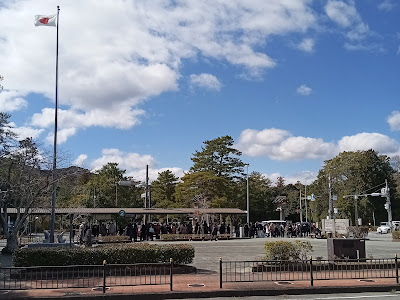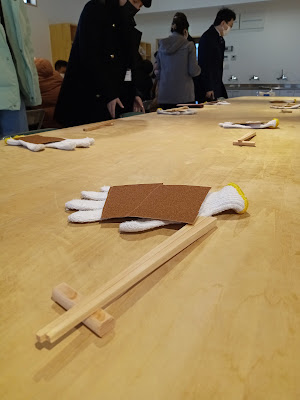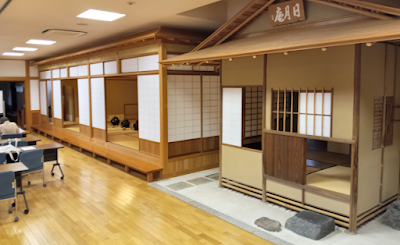 |
| At the Outer Shrine visitors await the bus to the Inner Shrine |
Much sun and moderate wind made Sunday a fine day to avoid the Outer Shrine crowds and walk along the Setagawa River, and then turn at the
Ise Furuichi Sangu Kaido (伊勢古市参宮街道) where it meets the river and walk along the rising narrow road as it curves this way and that way until it reaches the history center, the 伊勢古市参宮街道資料館, Ise Furuichi Sangu-kaido Shiryokan. According to the man in the office it was not until cars began to appear that the gravel surface was paved and thereby raised (between 1920 and 1930). The standard travel time in the Edo decades to get to Ise Jingu from the Tokyo (Edo) area was between 15 and 20 days on foot; about 5 from Kyoto or Osaka if making 30 km per day or faster. In those days the precincts around the Outer and Inner Shrines had some of the biggest, most well-known pleasure quarters - in the top five around the islands. Married pilgrims might see local sights (the view atop Mt. Asakuma, the Wedded Rocks at the seaside, and see some of the kabuki shows offered). Single men with money to spend might while away time with the 1,000 indentured young women whose families of the surrounding villages parted with them at age 7 or 8. From age 17 or 18 their time of entertaining and/or sex work could last for 10 years, according to the history center's host. Among the biggest operations were those of the Abura-ya, Sugimoto-ya, and Bizen-ya. |
| The Aburaya once stood near the line built by the Kintetsu company |
Among the many artifacts and stories in the museum were a water dipper (hishaku) that served as a kind of pilgrim's passport at the control gates along the highways and byways of Tokugawa times. And the custom of Ise residents hanging their New Year's shimenawa all year around comes up, too: written on the panel at the center of the decoration is reference to the Somin Shorai legend in which a poor man gives hospitality to a traveling god in disguise, who then grants the man protection from the spread of diseases. With pilgrims bringing microbes from all over the country, it makes sense to worry about the spread of infection, not unlike the Covid-19 precautions of the past three years, but without any vaccines or concept of pathogens. |
| text on the household protection: Somin Shorai legend |
All in all the walking, the bright sun shining on rooftops, leaves, and the water in the river was a delightful combination together with the history shared by the man at the museum. Thinking of all the livelihoods made possible by the Jingu for local residents, and also the consequences for those undertaking a once-in-a-lifetime pilgrimage, the many centuries of social impact of the Ise Jingu is long lasting, widespread, and sometimes life-changing in ways that may be for better or for worse, or some combination of good and bad. Even in this time of Internet, too much information, consumer careless handling of products, people, and places, still the Ise Jingu is shaping the lives of workers, religious specialists, scholars, pilgrims, and all manner of travelers inside and sometimes outside of Japan.
As a reminder that people are not always the most important part of the land and the ebb and flow of seasons, tides, and the orbits of the planets, the chance this afternoon to see this group of egrets on the Setagawa riverbank and upstream at the confluence of the Asagawa into the Setagawa, the 50 or 100 dark carp was wonderful.
 |
| collage of egrets (upper) and carp (lower), February 26 |







Comments
Post a Comment